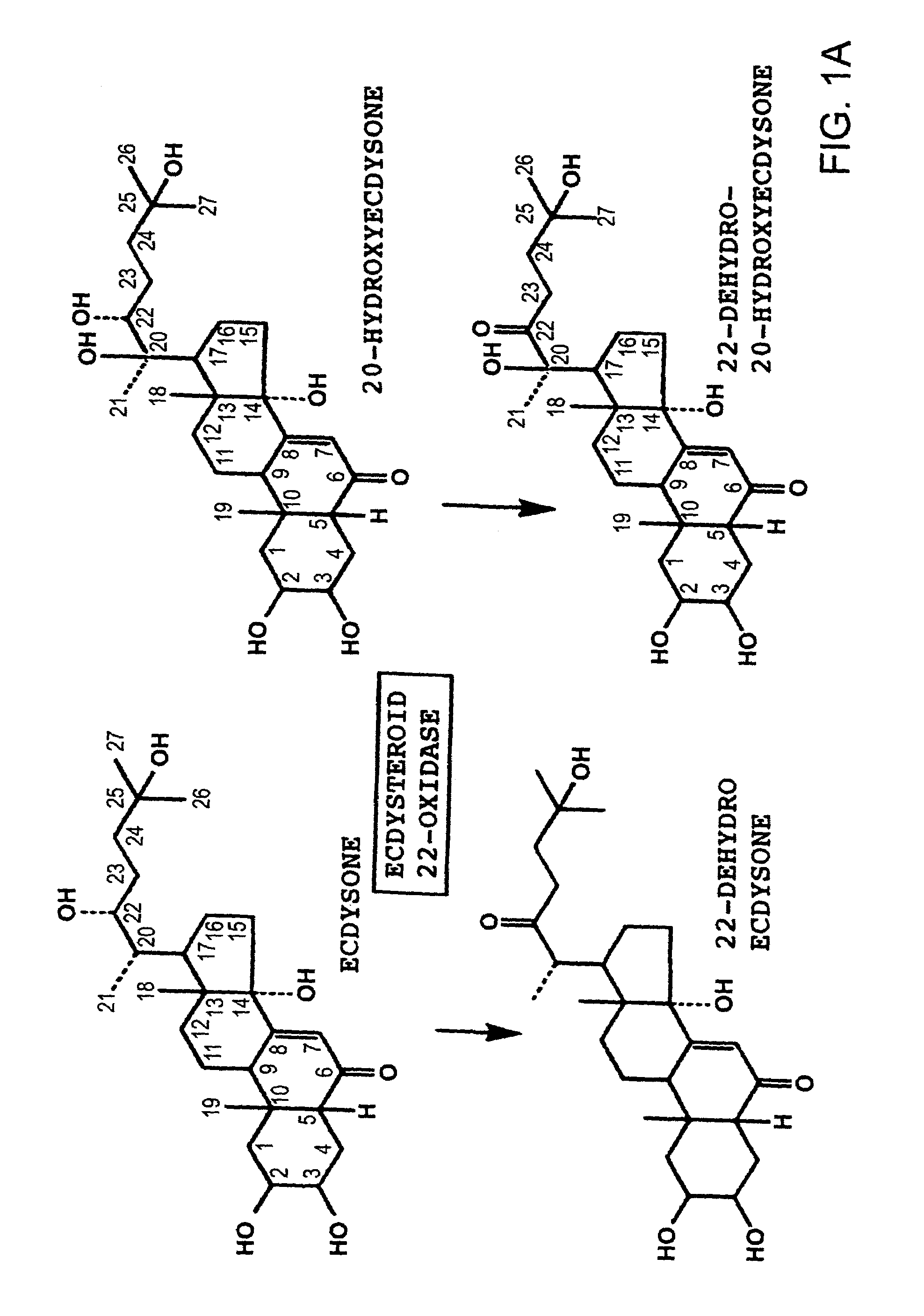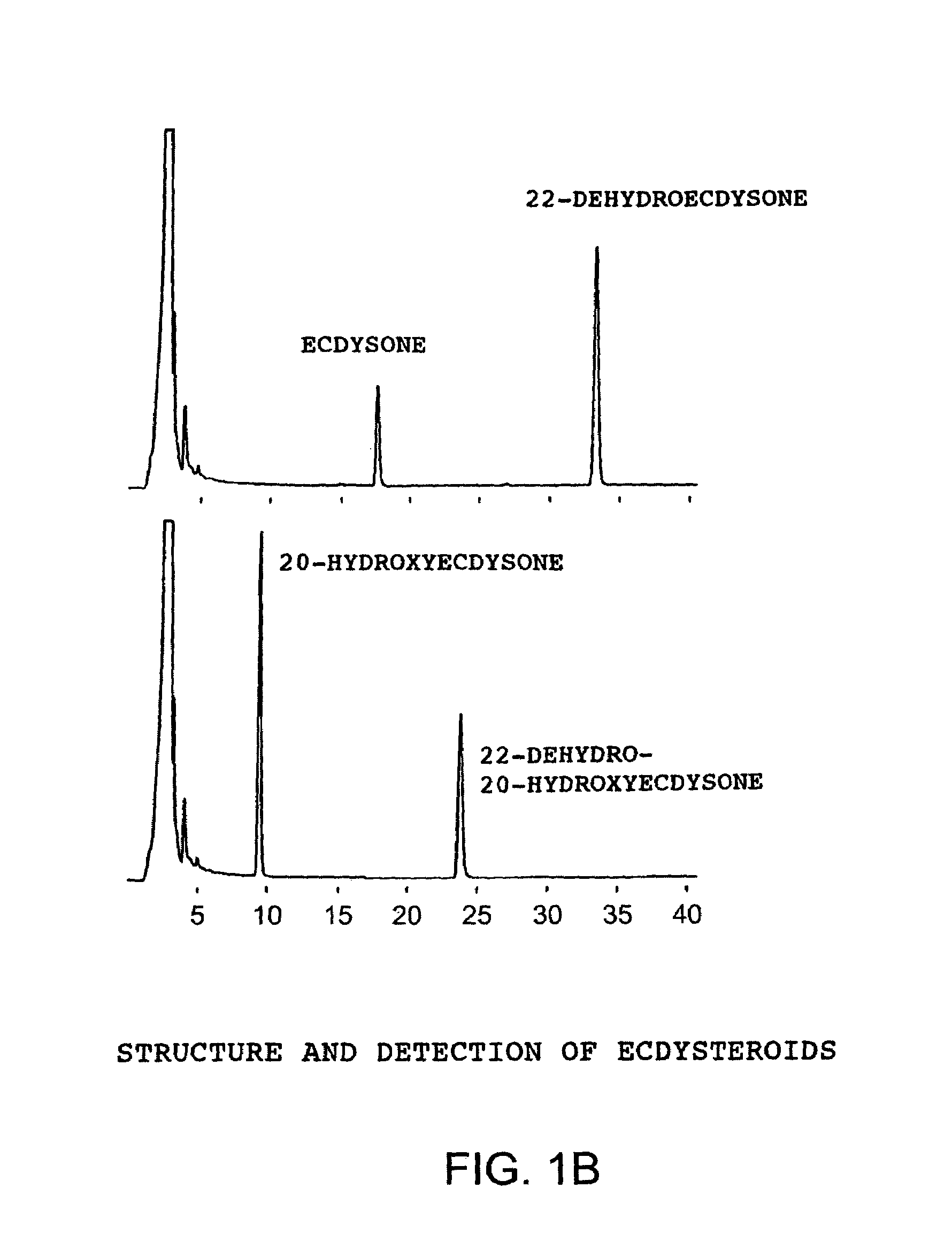Nomuraeae rileyi-origin ecdysteroid 22-oxidase and molt hormone inactivation system with the use of the same
a technology of molting hormone and ecdysteroid, which is applied in the field of molting hormone inactivation system with the use of the same, can solve the problems of not yet being put into practice as a purified enzyme preparation or recombinant protein, and hardly any techniques for reducing molting hormone activity, so as to achieve efficient inactivation of molting hormon
- Summary
- Abstract
- Description
- Claims
- Application Information
AI Technical Summary
Benefits of technology
Problems solved by technology
Method used
Image
Examples
example 1
Isolation of Ecdysteroid 22-oxidase from Nomuraea rileyi
[0046]Nomuraea rileyi was cultured for 9 days in a liquid culture medium containing an extract from silkworm larvae, the liquid culture (containing the target enzyme) was passed through a 0.45 μm filter, and then stored at 4° C. After collecting a sufficient amount of liquid culture, the enzyme was isolated by an extraction that involved the following 4 steps.[0047]1. Precipitation by 50% ammonium sulfate.[0048]2. Phenyl hydrophobic chromatography (using phenyl-Sepharose)[0049]3. Gel filtration (using Superdex 200 pg)[0050]4. Anionic chromatography (using HiTrap Q)
[0051]2 to 3 were carried out using HPLC (Model Bio-HPLC system, Tosoh).
[0052]In each process, an enzyme reaction was carried out using as a substrate ecdysone, which is described in FIG. 1A, and a fraction containing the target enzyme was determined by monitoring an oxidized product using HPLC. After final purification, SDS PAGE was carried out, and it was confirmed...
example 2
Determination of Ecdysteroid 22-oxidase Gene Sequence
[0053]The N-terminal sequence of the enzyme isolated according to the method described in Example 1 was first analyzed by an amino acid sequencer to determine the N-terminal amino acid sequence. Furthermore, the N-terminal sequence of a decomposition product obtained by partial decomposition of the enzyme preparation by V8 protease was analyzed by an amino acid sequencer to determine the internal amino acid sequence of this enzyme.
[0054]Based on the N-terminal sequence and the internal sequence of the enzyme thus determined, four types of degenerate primers were designed, that is, as forward primers, E22o.6 primer (SEQ ID NO:3; coding for the amino acid sequence LPQGGCR (21 to 27)) and E22o.2 primer (SEQ ID NO:4; coding for the amino acid sequence CRCIPGE (26 to 32)) and, as reverse primers, Int.R1 primer (SEQ ID NO:5; reverse coding for the amino acid sequence QNVNNAW (74 to 80)) and Int.R2 primer (SEQ ID NO:6; reverse coding for...
example 3
Effect of Ecdysteroid 22-oxidase on Silkworm Larvae
[0058]Fourth instar and fifth instar silkworm larvae were injected with an enzyme solution containing the enzyme according to the present invention at 1.6 units / 20 μl / head, and the growth thereafter was examined. ‘1 unit’ represents the enzyme activity that can oxidize 1 nM of ecdysone in 1 minute.
[0059]Fourth instar (penultimate instar) silkworm larvae usually molt into fifth instar (final instar) larvae approximately on Day 5, and fifth instar larvae start to form a cocoon approximately on Day 7 and pupate on the 11th day. However, when the present enzyme was injected into the body of a silkworm at the beginning of the fourth instar, it started to form a cocoon approximately 7 days after the injection and pupated 11 days later (FIG. 4A). On the other hand, when it was injected on the 7th day of the fifth instar, it remained in the larval stage for at least 10 days after the injection, and finally died without pupating (FIG. 4B).
[0...
PUM
| Property | Measurement | Unit |
|---|---|---|
| flow rate | aaaaa | aaaaa |
| diameter | aaaaa | aaaaa |
| concentration | aaaaa | aaaaa |
Abstract
Description
Claims
Application Information
 Login to View More
Login to View More - R&D
- Intellectual Property
- Life Sciences
- Materials
- Tech Scout
- Unparalleled Data Quality
- Higher Quality Content
- 60% Fewer Hallucinations
Browse by: Latest US Patents, China's latest patents, Technical Efficacy Thesaurus, Application Domain, Technology Topic, Popular Technical Reports.
© 2025 PatSnap. All rights reserved.Legal|Privacy policy|Modern Slavery Act Transparency Statement|Sitemap|About US| Contact US: help@patsnap.com



